Influenza Infection: Public Health Action Plan Report, Australia
VerifiedAdded on 2023/01/03
|12
|3081
|98
Report
AI Summary
This report provides a comprehensive analysis of influenza as a significant public health concern in Australia. It begins with an introduction to influenza, detailing its infectious nature, seasonal epidemics, and global impact, including symptoms, complications, and the burden of the disease, particularly on vulnerable populations like the elderly, pregnant women, and indigenous Australians. The report then delves into the public health issue, offering Australian statistics and discussing the virus strains, affected populations, and mortality rates, highlighting the underestimation of influenza's impact. Risk factors such as age, gender, chronic illnesses, and pregnancy are examined, emphasizing their contribution to the disease's spread and severity. Finally, the report explores various public health strategies, including vaccination programs, minimizing potential exposures, monitoring healthcare personnel, and monitoring influenza activity to mitigate and manage the infection effectively. The report underscores the need for targeted public health interventions to reduce the impact of influenza on the population.
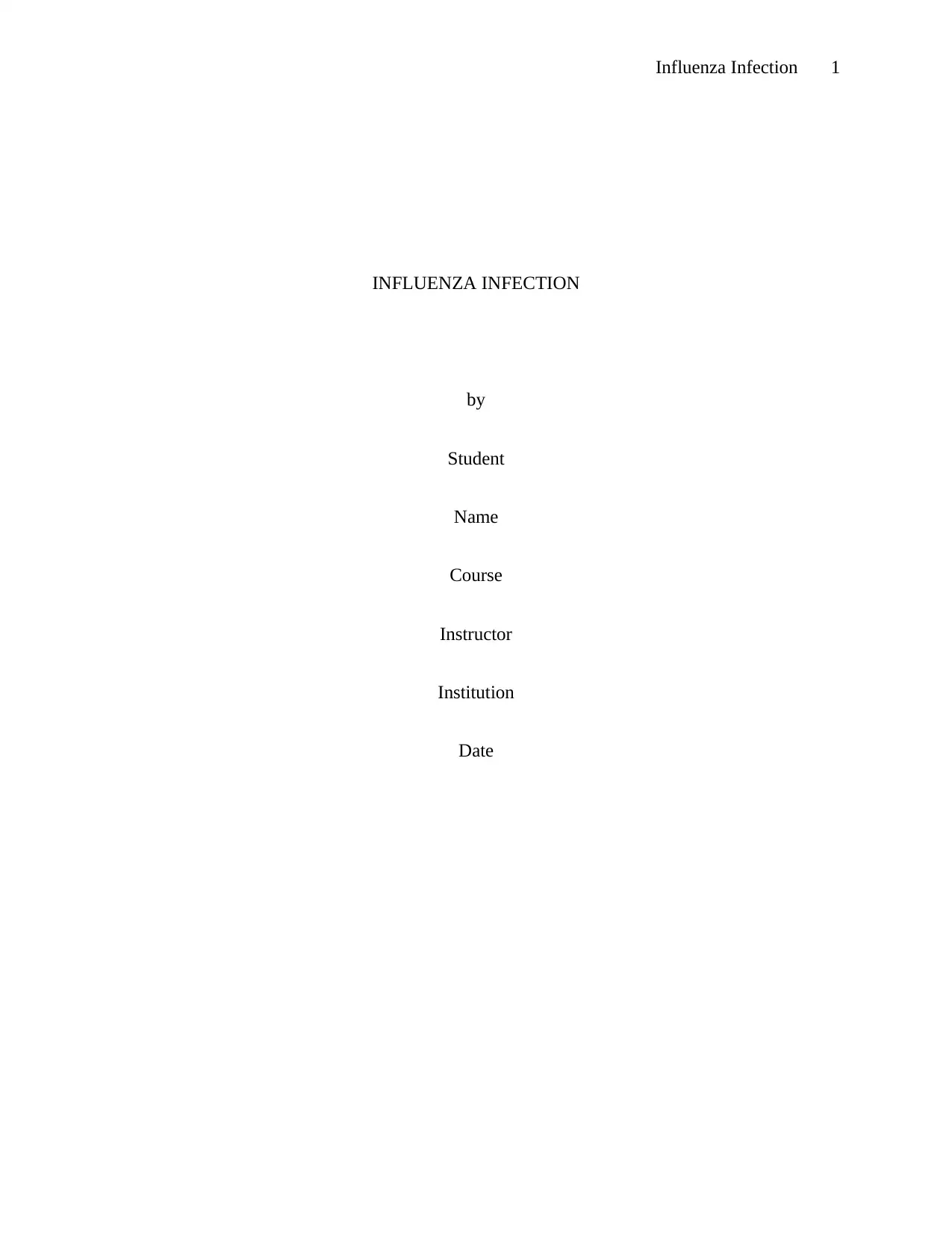
Influenza Infection 1
INFLUENZA INFECTION
by
Student
Name
Course
Instructor
Institution
Date
INFLUENZA INFECTION
by
Student
Name
Course
Instructor
Institution
Date
Paraphrase This Document
Need a fresh take? Get an instant paraphrase of this document with our AI Paraphraser
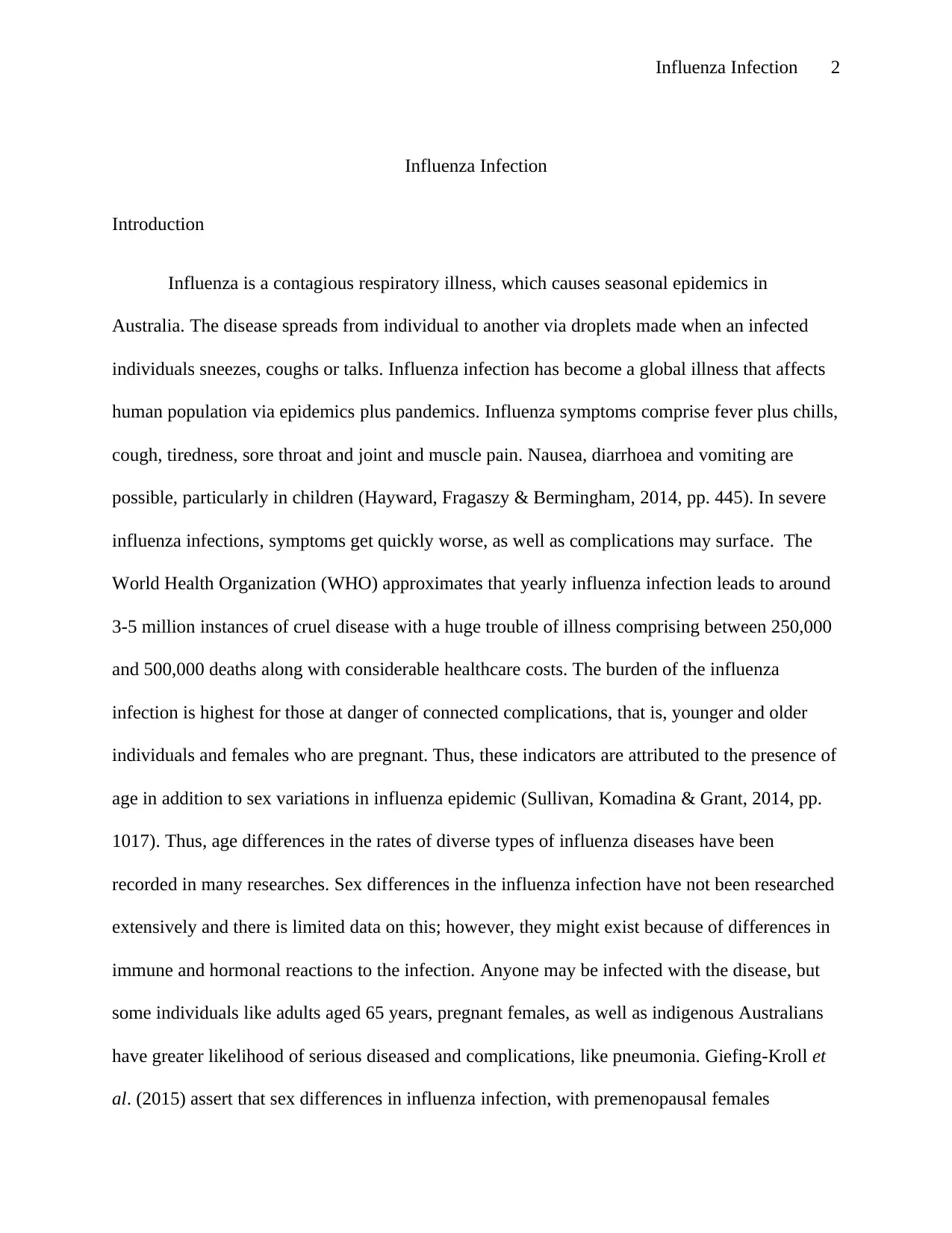
Influenza Infection 2
Influenza Infection
Introduction
Influenza is a contagious respiratory illness, which causes seasonal epidemics in
Australia. The disease spreads from individual to another via droplets made when an infected
individuals sneezes, coughs or talks. Influenza infection has become a global illness that affects
human population via epidemics plus pandemics. Influenza symptoms comprise fever plus chills,
cough, tiredness, sore throat and joint and muscle pain. Nausea, diarrhoea and vomiting are
possible, particularly in children (Hayward, Fragaszy & Bermingham, 2014, pp. 445). In severe
influenza infections, symptoms get quickly worse, as well as complications may surface. The
World Health Organization (WHO) approximates that yearly influenza infection leads to around
3-5 million instances of cruel disease with a huge trouble of illness comprising between 250,000
and 500,000 deaths along with considerable healthcare costs. The burden of the influenza
infection is highest for those at danger of connected complications, that is, younger and older
individuals and females who are pregnant. Thus, these indicators are attributed to the presence of
age in addition to sex variations in influenza epidemic (Sullivan, Komadina & Grant, 2014, pp.
1017). Thus, age differences in the rates of diverse types of influenza diseases have been
recorded in many researches. Sex differences in the influenza infection have not been researched
extensively and there is limited data on this; however, they might exist because of differences in
immune and hormonal reactions to the infection. Anyone may be infected with the disease, but
some individuals like adults aged 65 years, pregnant females, as well as indigenous Australians
have greater likelihood of serious diseased and complications, like pneumonia. Giefing-Kroll et
al. (2015) assert that sex differences in influenza infection, with premenopausal females
Influenza Infection
Introduction
Influenza is a contagious respiratory illness, which causes seasonal epidemics in
Australia. The disease spreads from individual to another via droplets made when an infected
individuals sneezes, coughs or talks. Influenza infection has become a global illness that affects
human population via epidemics plus pandemics. Influenza symptoms comprise fever plus chills,
cough, tiredness, sore throat and joint and muscle pain. Nausea, diarrhoea and vomiting are
possible, particularly in children (Hayward, Fragaszy & Bermingham, 2014, pp. 445). In severe
influenza infections, symptoms get quickly worse, as well as complications may surface. The
World Health Organization (WHO) approximates that yearly influenza infection leads to around
3-5 million instances of cruel disease with a huge trouble of illness comprising between 250,000
and 500,000 deaths along with considerable healthcare costs. The burden of the influenza
infection is highest for those at danger of connected complications, that is, younger and older
individuals and females who are pregnant. Thus, these indicators are attributed to the presence of
age in addition to sex variations in influenza epidemic (Sullivan, Komadina & Grant, 2014, pp.
1017). Thus, age differences in the rates of diverse types of influenza diseases have been
recorded in many researches. Sex differences in the influenza infection have not been researched
extensively and there is limited data on this; however, they might exist because of differences in
immune and hormonal reactions to the infection. Anyone may be infected with the disease, but
some individuals like adults aged 65 years, pregnant females, as well as indigenous Australians
have greater likelihood of serious diseased and complications, like pneumonia. Giefing-Kroll et
al. (2015) assert that sex differences in influenza infection, with premenopausal females
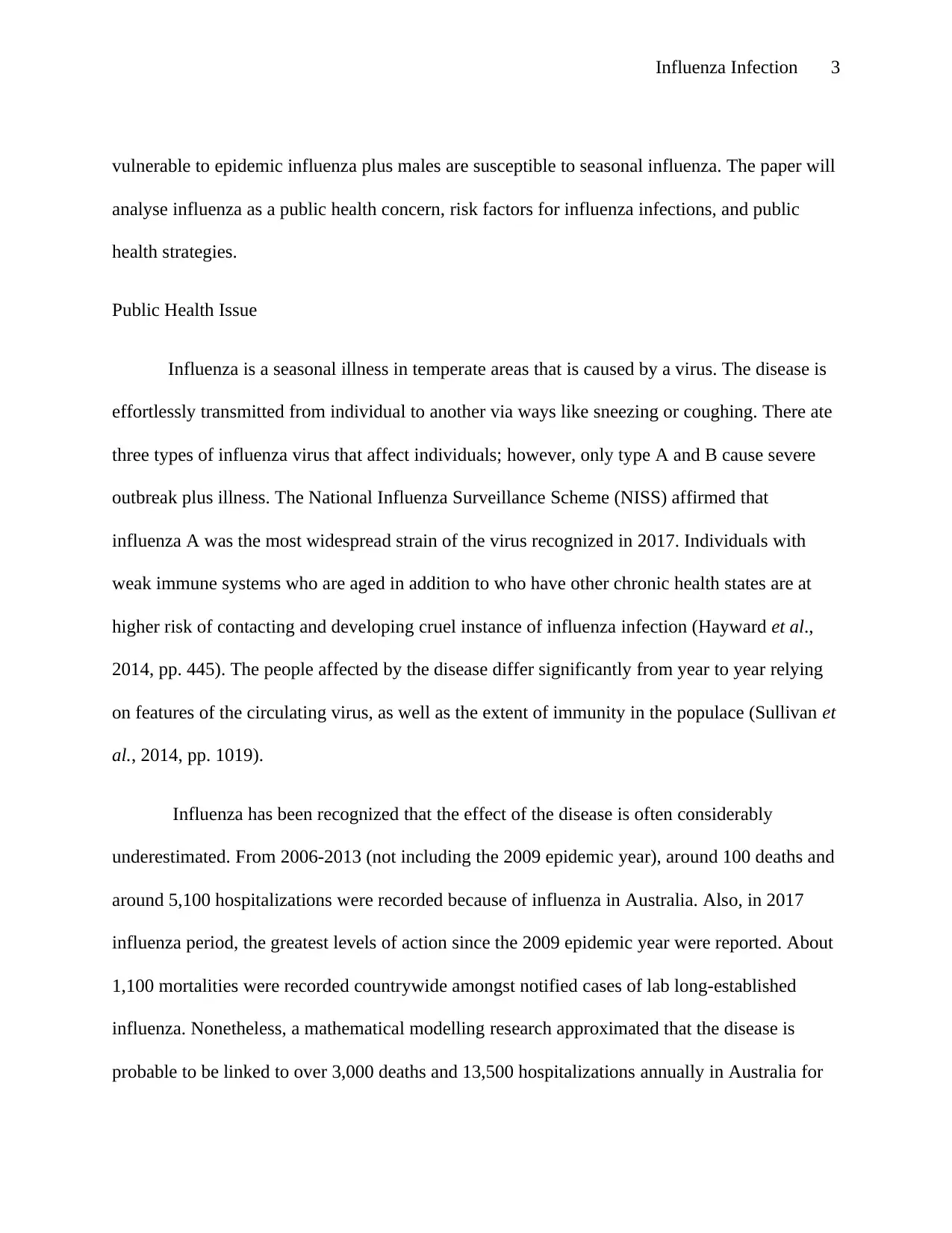
Influenza Infection 3
vulnerable to epidemic influenza plus males are susceptible to seasonal influenza. The paper will
analyse influenza as a public health concern, risk factors for influenza infections, and public
health strategies.
Public Health Issue
Influenza is a seasonal illness in temperate areas that is caused by a virus. The disease is
effortlessly transmitted from individual to another via ways like sneezing or coughing. There ate
three types of influenza virus that affect individuals; however, only type A and B cause severe
outbreak plus illness. The National Influenza Surveillance Scheme (NISS) affirmed that
influenza A was the most widespread strain of the virus recognized in 2017. Individuals with
weak immune systems who are aged in addition to who have other chronic health states are at
higher risk of contacting and developing cruel instance of influenza infection (Hayward et al.,
2014, pp. 445). The people affected by the disease differ significantly from year to year relying
on features of the circulating virus, as well as the extent of immunity in the populace (Sullivan et
al., 2014, pp. 1019).
Influenza has been recognized that the effect of the disease is often considerably
underestimated. From 2006-2013 (not including the 2009 epidemic year), around 100 deaths and
around 5,100 hospitalizations were recorded because of influenza in Australia. Also, in 2017
influenza period, the greatest levels of action since the 2009 epidemic year were reported. About
1,100 mortalities were recorded countrywide amongst notified cases of lab long-established
influenza. Nonetheless, a mathematical modelling research approximated that the disease is
probable to be linked to over 3,000 deaths and 13,500 hospitalizations annually in Australia for
vulnerable to epidemic influenza plus males are susceptible to seasonal influenza. The paper will
analyse influenza as a public health concern, risk factors for influenza infections, and public
health strategies.
Public Health Issue
Influenza is a seasonal illness in temperate areas that is caused by a virus. The disease is
effortlessly transmitted from individual to another via ways like sneezing or coughing. There ate
three types of influenza virus that affect individuals; however, only type A and B cause severe
outbreak plus illness. The National Influenza Surveillance Scheme (NISS) affirmed that
influenza A was the most widespread strain of the virus recognized in 2017. Individuals with
weak immune systems who are aged in addition to who have other chronic health states are at
higher risk of contacting and developing cruel instance of influenza infection (Hayward et al.,
2014, pp. 445). The people affected by the disease differ significantly from year to year relying
on features of the circulating virus, as well as the extent of immunity in the populace (Sullivan et
al., 2014, pp. 1019).
Influenza has been recognized that the effect of the disease is often considerably
underestimated. From 2006-2013 (not including the 2009 epidemic year), around 100 deaths and
around 5,100 hospitalizations were recorded because of influenza in Australia. Also, in 2017
influenza period, the greatest levels of action since the 2009 epidemic year were reported. About
1,100 mortalities were recorded countrywide amongst notified cases of lab long-established
influenza. Nonetheless, a mathematical modelling research approximated that the disease is
probable to be linked to over 3,000 deaths and 13,500 hospitalizations annually in Australia for
⊘ This is a preview!⊘
Do you want full access?
Subscribe today to unlock all pages.

Trusted by 1+ million students worldwide
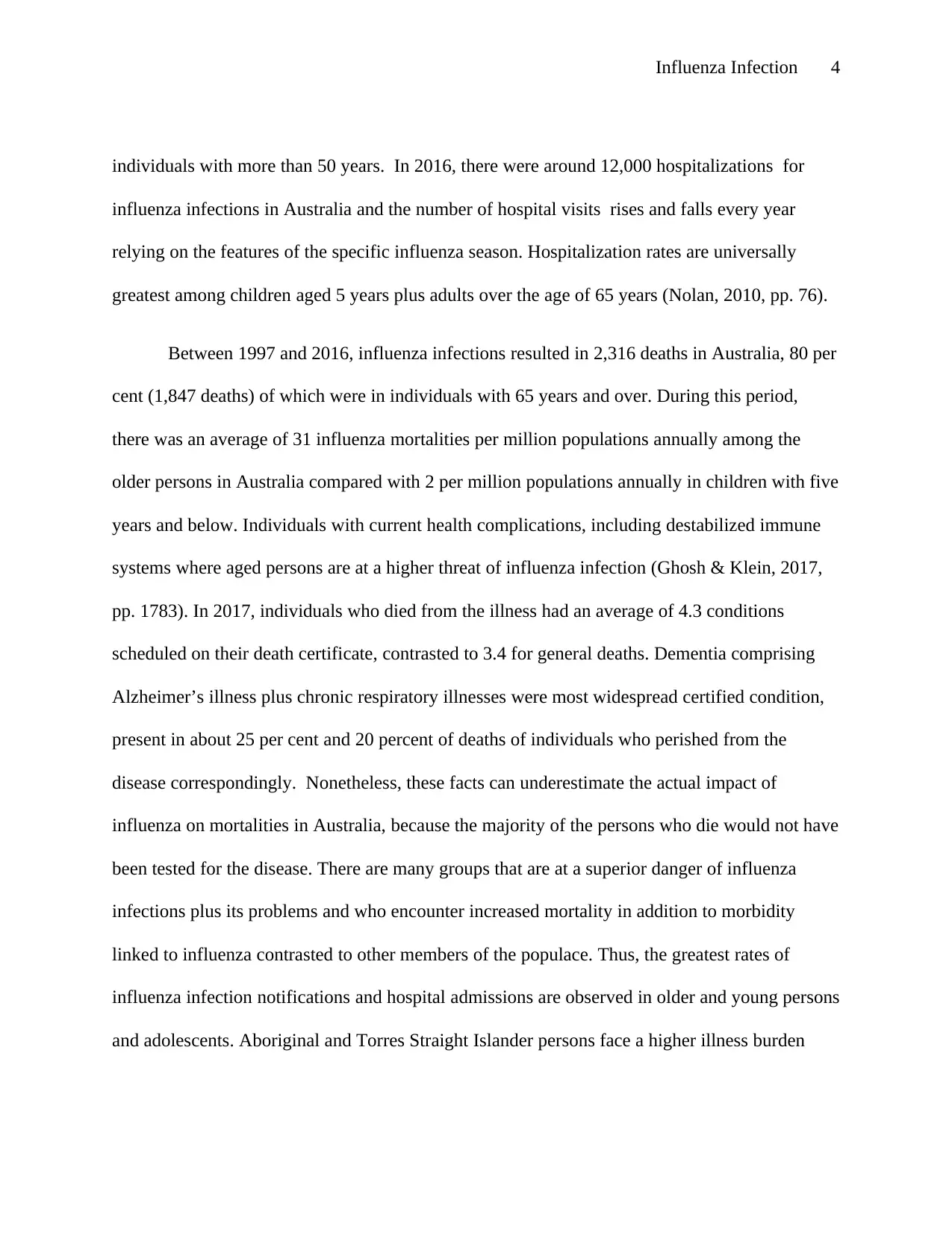
Influenza Infection 4
individuals with more than 50 years. In 2016, there were around 12,000 hospitalizations for
influenza infections in Australia and the number of hospital visits rises and falls every year
relying on the features of the specific influenza season. Hospitalization rates are universally
greatest among children aged 5 years plus adults over the age of 65 years (Nolan, 2010, pp. 76).
Between 1997 and 2016, influenza infections resulted in 2,316 deaths in Australia, 80 per
cent (1,847 deaths) of which were in individuals with 65 years and over. During this period,
there was an average of 31 influenza mortalities per million populations annually among the
older persons in Australia compared with 2 per million populations annually in children with five
years and below. Individuals with current health complications, including destabilized immune
systems where aged persons are at a higher threat of influenza infection (Ghosh & Klein, 2017,
pp. 1783). In 2017, individuals who died from the illness had an average of 4.3 conditions
scheduled on their death certificate, contrasted to 3.4 for general deaths. Dementia comprising
Alzheimer’s illness plus chronic respiratory illnesses were most widespread certified condition,
present in about 25 per cent and 20 percent of deaths of individuals who perished from the
disease correspondingly. Nonetheless, these facts can underestimate the actual impact of
influenza on mortalities in Australia, because the majority of the persons who die would not have
been tested for the disease. There are many groups that are at a superior danger of influenza
infections plus its problems and who encounter increased mortality in addition to morbidity
linked to influenza contrasted to other members of the populace. Thus, the greatest rates of
influenza infection notifications and hospital admissions are observed in older and young persons
and adolescents. Aboriginal and Torres Straight Islander persons face a higher illness burden
individuals with more than 50 years. In 2016, there were around 12,000 hospitalizations for
influenza infections in Australia and the number of hospital visits rises and falls every year
relying on the features of the specific influenza season. Hospitalization rates are universally
greatest among children aged 5 years plus adults over the age of 65 years (Nolan, 2010, pp. 76).
Between 1997 and 2016, influenza infections resulted in 2,316 deaths in Australia, 80 per
cent (1,847 deaths) of which were in individuals with 65 years and over. During this period,
there was an average of 31 influenza mortalities per million populations annually among the
older persons in Australia compared with 2 per million populations annually in children with five
years and below. Individuals with current health complications, including destabilized immune
systems where aged persons are at a higher threat of influenza infection (Ghosh & Klein, 2017,
pp. 1783). In 2017, individuals who died from the illness had an average of 4.3 conditions
scheduled on their death certificate, contrasted to 3.4 for general deaths. Dementia comprising
Alzheimer’s illness plus chronic respiratory illnesses were most widespread certified condition,
present in about 25 per cent and 20 percent of deaths of individuals who perished from the
disease correspondingly. Nonetheless, these facts can underestimate the actual impact of
influenza on mortalities in Australia, because the majority of the persons who die would not have
been tested for the disease. There are many groups that are at a superior danger of influenza
infections plus its problems and who encounter increased mortality in addition to morbidity
linked to influenza contrasted to other members of the populace. Thus, the greatest rates of
influenza infection notifications and hospital admissions are observed in older and young persons
and adolescents. Aboriginal and Torres Straight Islander persons face a higher illness burden
Paraphrase This Document
Need a fresh take? Get an instant paraphrase of this document with our AI Paraphraser
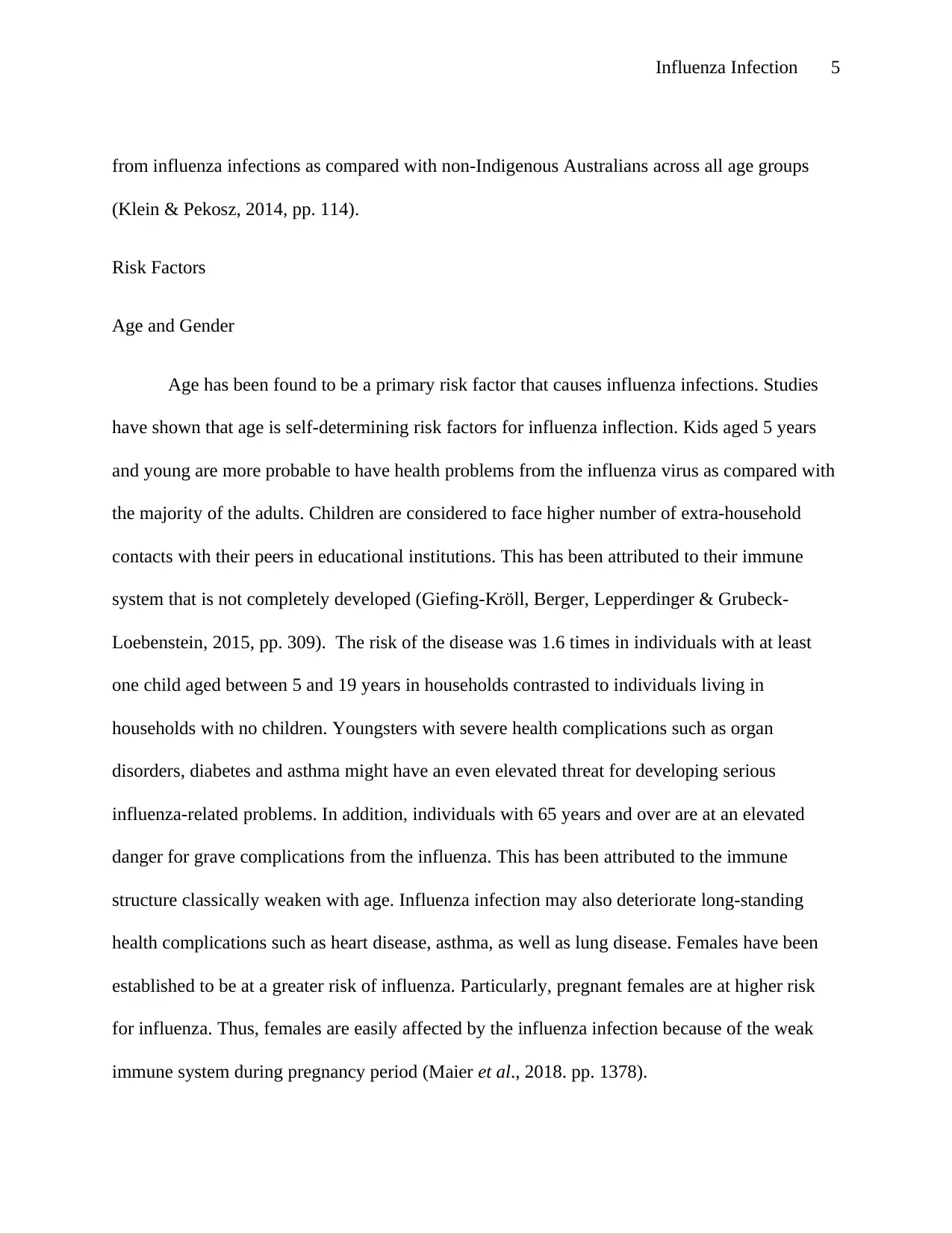
Influenza Infection 5
from influenza infections as compared with non-Indigenous Australians across all age groups
(Klein & Pekosz, 2014, pp. 114).
Risk Factors
Age and Gender
Age has been found to be a primary risk factor that causes influenza infections. Studies
have shown that age is self-determining risk factors for influenza inflection. Kids aged 5 years
and young are more probable to have health problems from the influenza virus as compared with
the majority of the adults. Children are considered to face higher number of extra-household
contacts with their peers in educational institutions. This has been attributed to their immune
system that is not completely developed (Giefing-Kröll, Berger, Lepperdinger & Grubeck-
Loebenstein, 2015, pp. 309). The risk of the disease was 1.6 times in individuals with at least
one child aged between 5 and 19 years in households contrasted to individuals living in
households with no children. Youngsters with severe health complications such as organ
disorders, diabetes and asthma might have an even elevated threat for developing serious
influenza-related problems. In addition, individuals with 65 years and over are at an elevated
danger for grave complications from the influenza. This has been attributed to the immune
structure classically weaken with age. Influenza infection may also deteriorate long-standing
health complications such as heart disease, asthma, as well as lung disease. Females have been
established to be at a greater risk of influenza. Particularly, pregnant females are at higher risk
for influenza. Thus, females are easily affected by the influenza infection because of the weak
immune system during pregnancy period (Maier et al., 2018. pp. 1378).
from influenza infections as compared with non-Indigenous Australians across all age groups
(Klein & Pekosz, 2014, pp. 114).
Risk Factors
Age and Gender
Age has been found to be a primary risk factor that causes influenza infections. Studies
have shown that age is self-determining risk factors for influenza inflection. Kids aged 5 years
and young are more probable to have health problems from the influenza virus as compared with
the majority of the adults. Children are considered to face higher number of extra-household
contacts with their peers in educational institutions. This has been attributed to their immune
system that is not completely developed (Giefing-Kröll, Berger, Lepperdinger & Grubeck-
Loebenstein, 2015, pp. 309). The risk of the disease was 1.6 times in individuals with at least
one child aged between 5 and 19 years in households contrasted to individuals living in
households with no children. Youngsters with severe health complications such as organ
disorders, diabetes and asthma might have an even elevated threat for developing serious
influenza-related problems. In addition, individuals with 65 years and over are at an elevated
danger for grave complications from the influenza. This has been attributed to the immune
structure classically weaken with age. Influenza infection may also deteriorate long-standing
health complications such as heart disease, asthma, as well as lung disease. Females have been
established to be at a greater risk of influenza. Particularly, pregnant females are at higher risk
for influenza. Thus, females are easily affected by the influenza infection because of the weak
immune system during pregnancy period (Maier et al., 2018. pp. 1378).
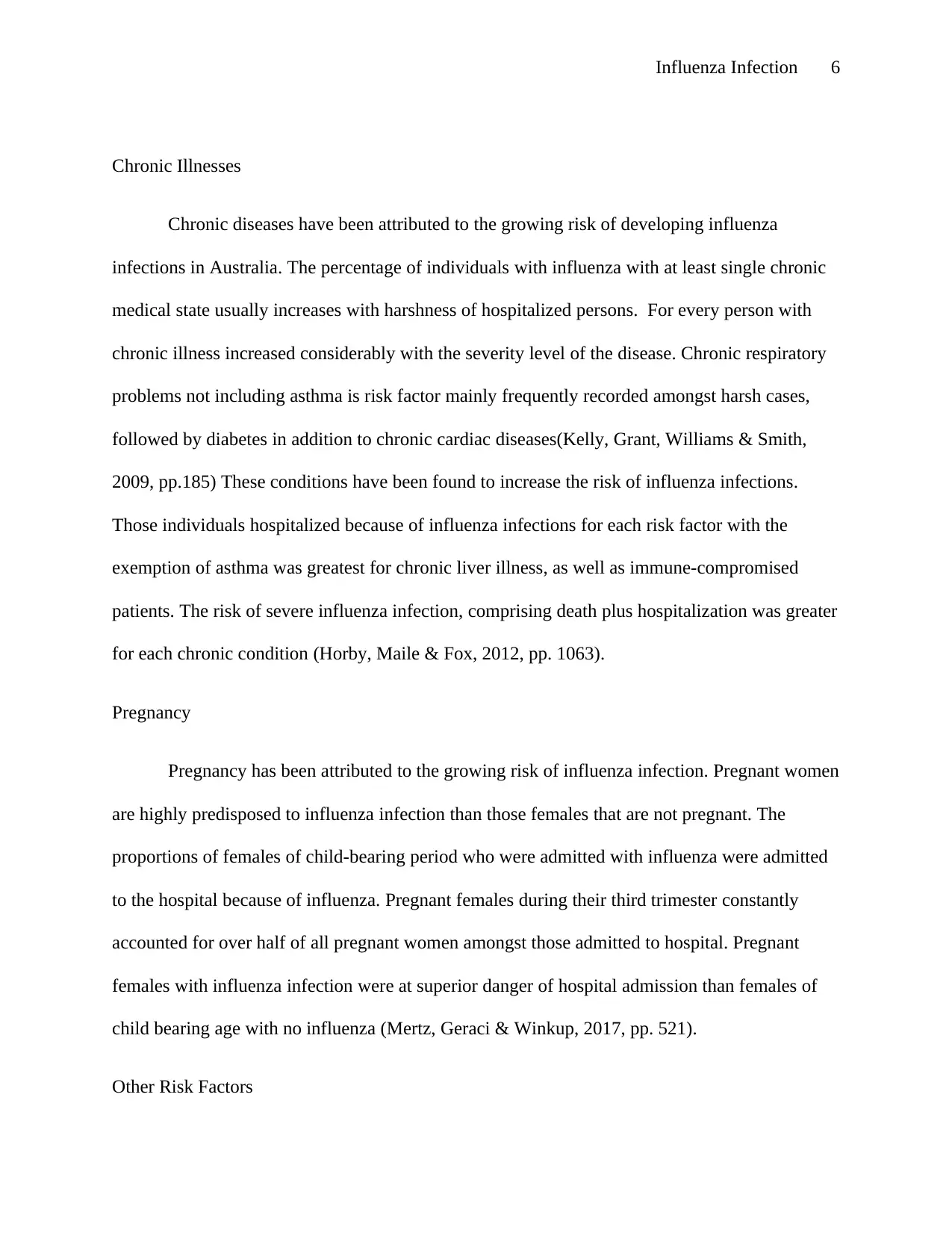
Influenza Infection 6
Chronic Illnesses
Chronic diseases have been attributed to the growing risk of developing influenza
infections in Australia. The percentage of individuals with influenza with at least single chronic
medical state usually increases with harshness of hospitalized persons. For every person with
chronic illness increased considerably with the severity level of the disease. Chronic respiratory
problems not including asthma is risk factor mainly frequently recorded amongst harsh cases,
followed by diabetes in addition to chronic cardiac diseases(Kelly, Grant, Williams & Smith,
2009, pp.185) These conditions have been found to increase the risk of influenza infections.
Those individuals hospitalized because of influenza infections for each risk factor with the
exemption of asthma was greatest for chronic liver illness, as well as immune-compromised
patients. The risk of severe influenza infection, comprising death plus hospitalization was greater
for each chronic condition (Horby, Maile & Fox, 2012, pp. 1063).
Pregnancy
Pregnancy has been attributed to the growing risk of influenza infection. Pregnant women
are highly predisposed to influenza infection than those females that are not pregnant. The
proportions of females of child-bearing period who were admitted with influenza were admitted
to the hospital because of influenza. Pregnant females during their third trimester constantly
accounted for over half of all pregnant women amongst those admitted to hospital. Pregnant
females with influenza infection were at superior danger of hospital admission than females of
child bearing age with no influenza (Mertz, Geraci & Winkup, 2017, pp. 521).
Other Risk Factors
Chronic Illnesses
Chronic diseases have been attributed to the growing risk of developing influenza
infections in Australia. The percentage of individuals with influenza with at least single chronic
medical state usually increases with harshness of hospitalized persons. For every person with
chronic illness increased considerably with the severity level of the disease. Chronic respiratory
problems not including asthma is risk factor mainly frequently recorded amongst harsh cases,
followed by diabetes in addition to chronic cardiac diseases(Kelly, Grant, Williams & Smith,
2009, pp.185) These conditions have been found to increase the risk of influenza infections.
Those individuals hospitalized because of influenza infections for each risk factor with the
exemption of asthma was greatest for chronic liver illness, as well as immune-compromised
patients. The risk of severe influenza infection, comprising death plus hospitalization was greater
for each chronic condition (Horby, Maile & Fox, 2012, pp. 1063).
Pregnancy
Pregnancy has been attributed to the growing risk of influenza infection. Pregnant women
are highly predisposed to influenza infection than those females that are not pregnant. The
proportions of females of child-bearing period who were admitted with influenza were admitted
to the hospital because of influenza. Pregnant females during their third trimester constantly
accounted for over half of all pregnant women amongst those admitted to hospital. Pregnant
females with influenza infection were at superior danger of hospital admission than females of
child bearing age with no influenza (Mertz, Geraci & Winkup, 2017, pp. 521).
Other Risk Factors
⊘ This is a preview!⊘
Do you want full access?
Subscribe today to unlock all pages.

Trusted by 1+ million students worldwide
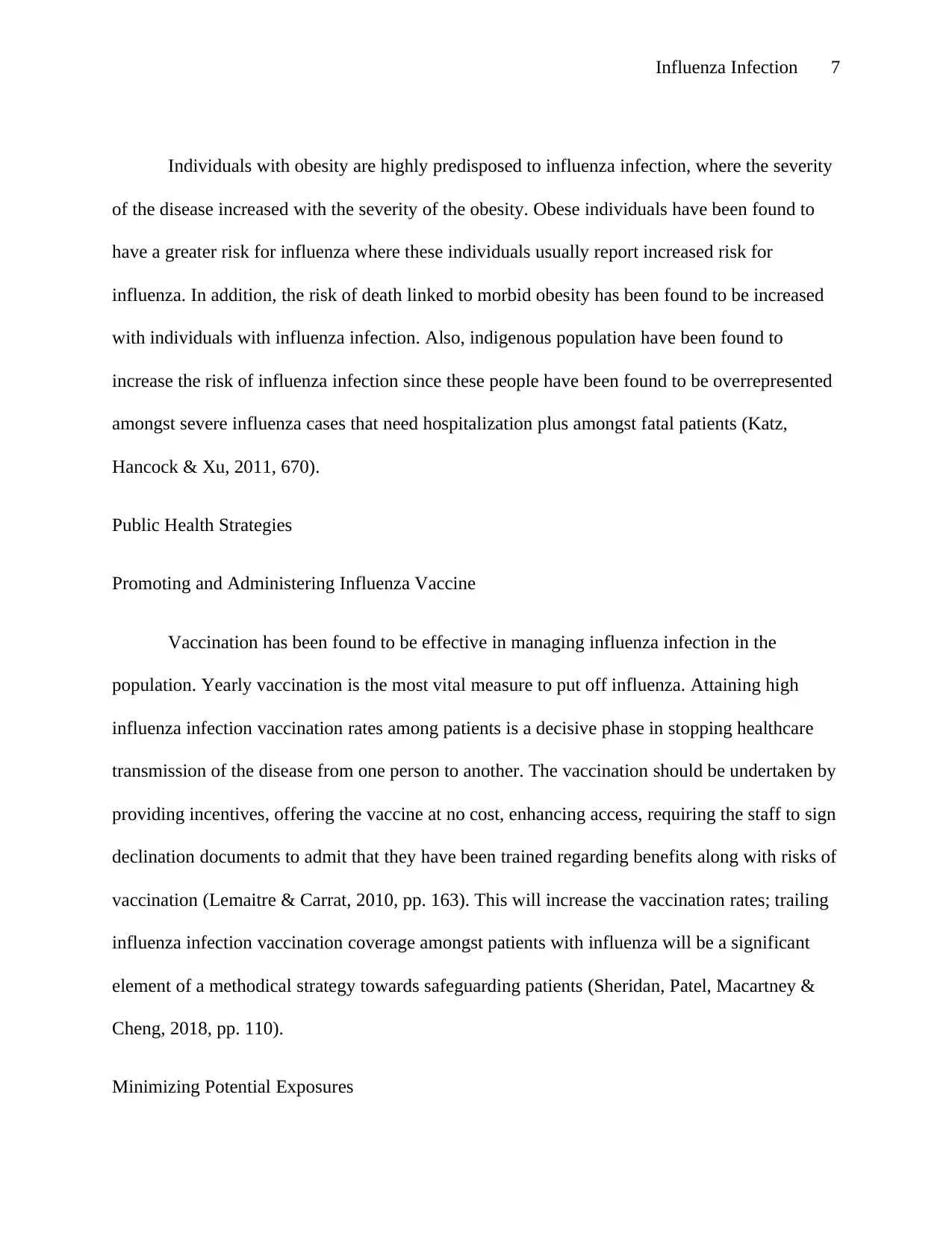
Influenza Infection 7
Individuals with obesity are highly predisposed to influenza infection, where the severity
of the disease increased with the severity of the obesity. Obese individuals have been found to
have a greater risk for influenza where these individuals usually report increased risk for
influenza. In addition, the risk of death linked to morbid obesity has been found to be increased
with individuals with influenza infection. Also, indigenous population have been found to
increase the risk of influenza infection since these people have been found to be overrepresented
amongst severe influenza cases that need hospitalization plus amongst fatal patients (Katz,
Hancock & Xu, 2011, 670).
Public Health Strategies
Promoting and Administering Influenza Vaccine
Vaccination has been found to be effective in managing influenza infection in the
population. Yearly vaccination is the most vital measure to put off influenza. Attaining high
influenza infection vaccination rates among patients is a decisive phase in stopping healthcare
transmission of the disease from one person to another. The vaccination should be undertaken by
providing incentives, offering the vaccine at no cost, enhancing access, requiring the staff to sign
declination documents to admit that they have been trained regarding benefits along with risks of
vaccination (Lemaitre & Carrat, 2010, pp. 163). This will increase the vaccination rates; trailing
influenza infection vaccination coverage amongst patients with influenza will be a significant
element of a methodical strategy towards safeguarding patients (Sheridan, Patel, Macartney &
Cheng, 2018, pp. 110).
Minimizing Potential Exposures
Individuals with obesity are highly predisposed to influenza infection, where the severity
of the disease increased with the severity of the obesity. Obese individuals have been found to
have a greater risk for influenza where these individuals usually report increased risk for
influenza. In addition, the risk of death linked to morbid obesity has been found to be increased
with individuals with influenza infection. Also, indigenous population have been found to
increase the risk of influenza infection since these people have been found to be overrepresented
amongst severe influenza cases that need hospitalization plus amongst fatal patients (Katz,
Hancock & Xu, 2011, 670).
Public Health Strategies
Promoting and Administering Influenza Vaccine
Vaccination has been found to be effective in managing influenza infection in the
population. Yearly vaccination is the most vital measure to put off influenza. Attaining high
influenza infection vaccination rates among patients is a decisive phase in stopping healthcare
transmission of the disease from one person to another. The vaccination should be undertaken by
providing incentives, offering the vaccine at no cost, enhancing access, requiring the staff to sign
declination documents to admit that they have been trained regarding benefits along with risks of
vaccination (Lemaitre & Carrat, 2010, pp. 163). This will increase the vaccination rates; trailing
influenza infection vaccination coverage amongst patients with influenza will be a significant
element of a methodical strategy towards safeguarding patients (Sheridan, Patel, Macartney &
Cheng, 2018, pp. 110).
Minimizing Potential Exposures
Paraphrase This Document
Need a fresh take? Get an instant paraphrase of this document with our AI Paraphraser
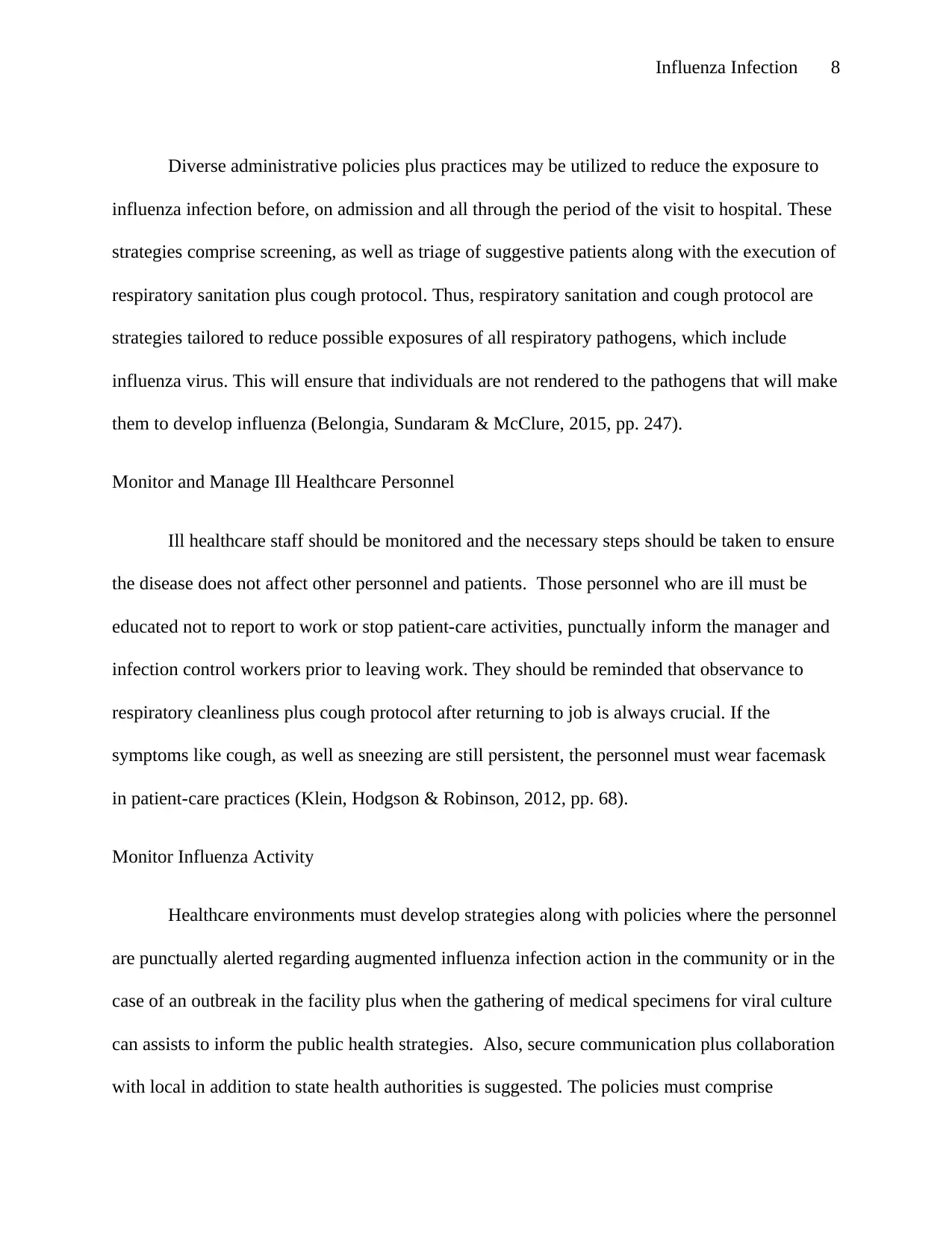
Influenza Infection 8
Diverse administrative policies plus practices may be utilized to reduce the exposure to
influenza infection before, on admission and all through the period of the visit to hospital. These
strategies comprise screening, as well as triage of suggestive patients along with the execution of
respiratory sanitation plus cough protocol. Thus, respiratory sanitation and cough protocol are
strategies tailored to reduce possible exposures of all respiratory pathogens, which include
influenza virus. This will ensure that individuals are not rendered to the pathogens that will make
them to develop influenza (Belongia, Sundaram & McClure, 2015, pp. 247).
Monitor and Manage Ill Healthcare Personnel
Ill healthcare staff should be monitored and the necessary steps should be taken to ensure
the disease does not affect other personnel and patients. Those personnel who are ill must be
educated not to report to work or stop patient-care activities, punctually inform the manager and
infection control workers prior to leaving work. They should be reminded that observance to
respiratory cleanliness plus cough protocol after returning to job is always crucial. If the
symptoms like cough, as well as sneezing are still persistent, the personnel must wear facemask
in patient-care practices (Klein, Hodgson & Robinson, 2012, pp. 68).
Monitor Influenza Activity
Healthcare environments must develop strategies along with policies where the personnel
are punctually alerted regarding augmented influenza infection action in the community or in the
case of an outbreak in the facility plus when the gathering of medical specimens for viral culture
can assists to inform the public health strategies. Also, secure communication plus collaboration
with local in addition to state health authorities is suggested. The policies must comprise
Diverse administrative policies plus practices may be utilized to reduce the exposure to
influenza infection before, on admission and all through the period of the visit to hospital. These
strategies comprise screening, as well as triage of suggestive patients along with the execution of
respiratory sanitation plus cough protocol. Thus, respiratory sanitation and cough protocol are
strategies tailored to reduce possible exposures of all respiratory pathogens, which include
influenza virus. This will ensure that individuals are not rendered to the pathogens that will make
them to develop influenza (Belongia, Sundaram & McClure, 2015, pp. 247).
Monitor and Manage Ill Healthcare Personnel
Ill healthcare staff should be monitored and the necessary steps should be taken to ensure
the disease does not affect other personnel and patients. Those personnel who are ill must be
educated not to report to work or stop patient-care activities, punctually inform the manager and
infection control workers prior to leaving work. They should be reminded that observance to
respiratory cleanliness plus cough protocol after returning to job is always crucial. If the
symptoms like cough, as well as sneezing are still persistent, the personnel must wear facemask
in patient-care practices (Klein, Hodgson & Robinson, 2012, pp. 68).
Monitor Influenza Activity
Healthcare environments must develop strategies along with policies where the personnel
are punctually alerted regarding augmented influenza infection action in the community or in the
case of an outbreak in the facility plus when the gathering of medical specimens for viral culture
can assists to inform the public health strategies. Also, secure communication plus collaboration
with local in addition to state health authorities is suggested. The policies must comprise
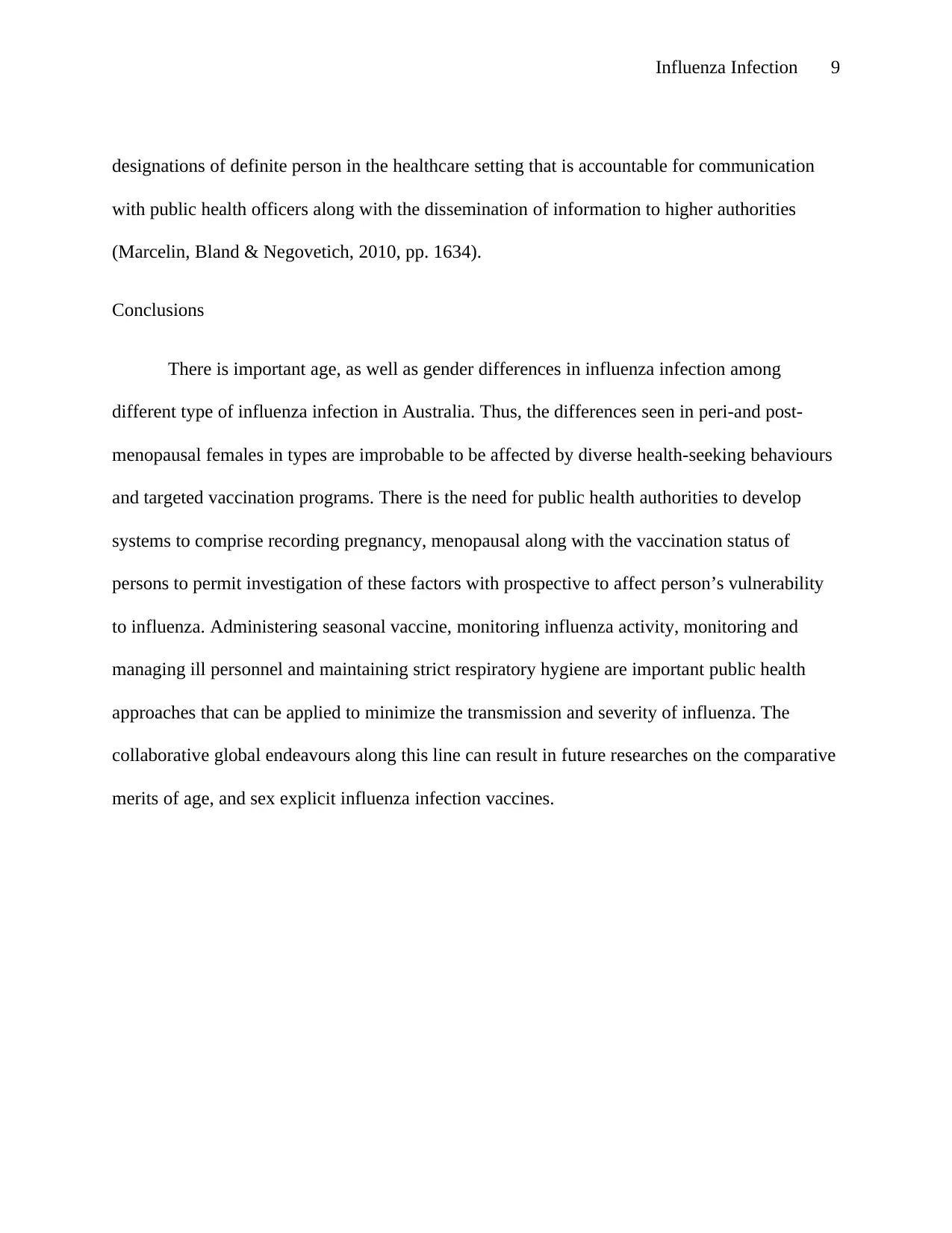
Influenza Infection 9
designations of definite person in the healthcare setting that is accountable for communication
with public health officers along with the dissemination of information to higher authorities
(Marcelin, Bland & Negovetich, 2010, pp. 1634).
Conclusions
There is important age, as well as gender differences in influenza infection among
different type of influenza infection in Australia. Thus, the differences seen in peri-and post-
menopausal females in types are improbable to be affected by diverse health-seeking behaviours
and targeted vaccination programs. There is the need for public health authorities to develop
systems to comprise recording pregnancy, menopausal along with the vaccination status of
persons to permit investigation of these factors with prospective to affect person’s vulnerability
to influenza. Administering seasonal vaccine, monitoring influenza activity, monitoring and
managing ill personnel and maintaining strict respiratory hygiene are important public health
approaches that can be applied to minimize the transmission and severity of influenza. The
collaborative global endeavours along this line can result in future researches on the comparative
merits of age, and sex explicit influenza infection vaccines.
designations of definite person in the healthcare setting that is accountable for communication
with public health officers along with the dissemination of information to higher authorities
(Marcelin, Bland & Negovetich, 2010, pp. 1634).
Conclusions
There is important age, as well as gender differences in influenza infection among
different type of influenza infection in Australia. Thus, the differences seen in peri-and post-
menopausal females in types are improbable to be affected by diverse health-seeking behaviours
and targeted vaccination programs. There is the need for public health authorities to develop
systems to comprise recording pregnancy, menopausal along with the vaccination status of
persons to permit investigation of these factors with prospective to affect person’s vulnerability
to influenza. Administering seasonal vaccine, monitoring influenza activity, monitoring and
managing ill personnel and maintaining strict respiratory hygiene are important public health
approaches that can be applied to minimize the transmission and severity of influenza. The
collaborative global endeavours along this line can result in future researches on the comparative
merits of age, and sex explicit influenza infection vaccines.
⊘ This is a preview!⊘
Do you want full access?
Subscribe today to unlock all pages.

Trusted by 1+ million students worldwide
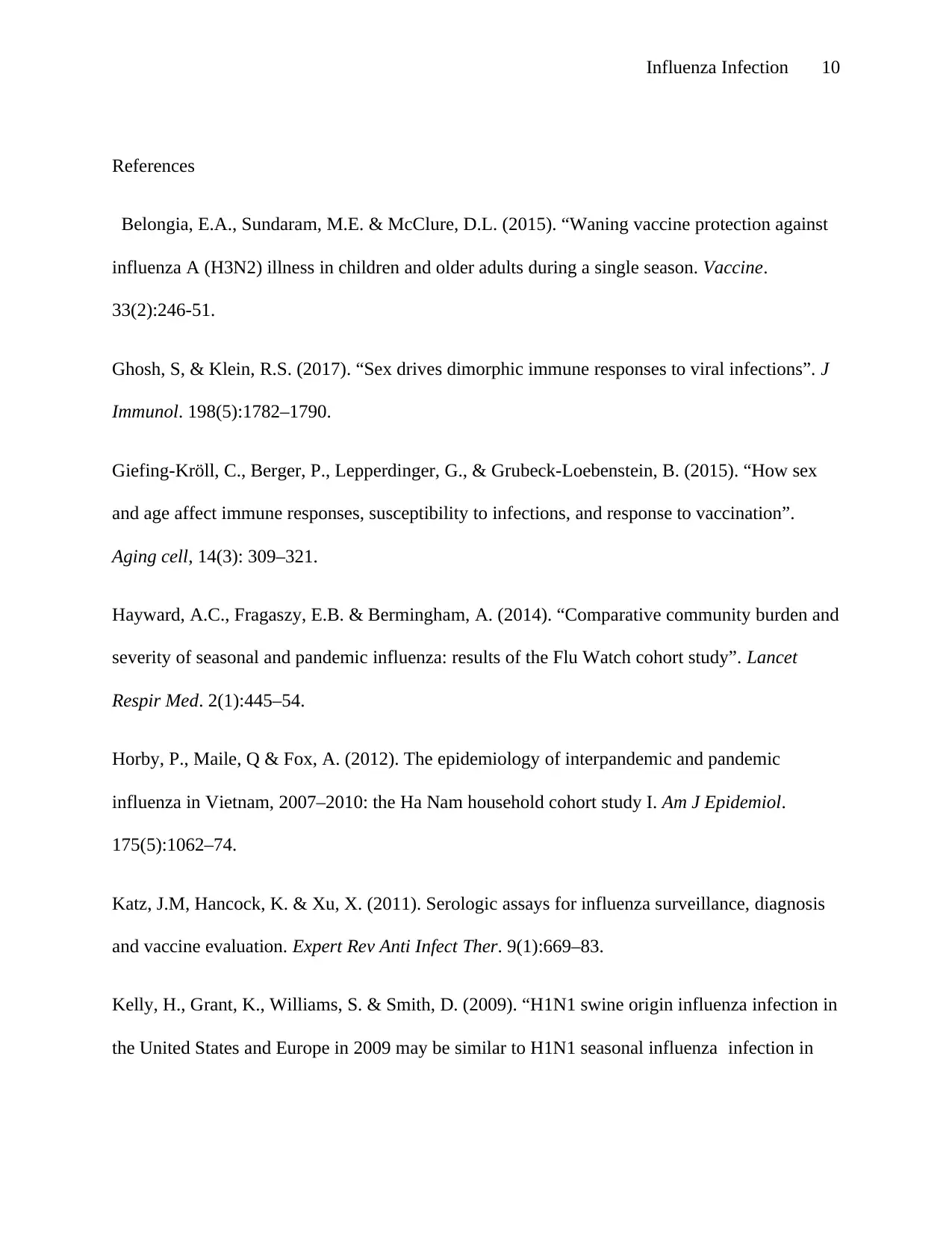
Influenza Infection 10
References
Belongia, E.A., Sundaram, M.E. & McClure, D.L. (2015). “Waning vaccine protection against
influenza A (H3N2) illness in children and older adults during a single season. Vaccine.
33(2):246-51.
Ghosh, S, & Klein, R.S. (2017). “Sex drives dimorphic immune responses to viral infections”. J
Immunol. 198(5):1782–1790.
Giefing-Kröll, C., Berger, P., Lepperdinger, G., & Grubeck-Loebenstein, B. (2015). “How sex
and age affect immune responses, susceptibility to infections, and response to vaccination”.
Aging cell, 14(3): 309–321.
Hayward, A.C., Fragaszy, E.B. & Bermingham, A. (2014). “Comparative community burden and
severity of seasonal and pandemic influenza: results of the Flu Watch cohort study”. Lancet
Respir Med. 2(1):445–54.
Horby, P., Maile, Q & Fox, A. (2012). The epidemiology of interpandemic and pandemic
influenza in Vietnam, 2007–2010: the Ha Nam household cohort study I. Am J Epidemiol.
175(5):1062–74.
Katz, J.M, Hancock, K. & Xu, X. (2011). Serologic assays for influenza surveillance, diagnosis
and vaccine evaluation. Expert Rev Anti Infect Ther. 9(1):669–83.
Kelly, H., Grant, K., Williams, S. & Smith, D. (2009). “H1N1 swine origin influenza infection in
the United States and Europe in 2009 may be similar to H1N1 seasonal influenza infection in
References
Belongia, E.A., Sundaram, M.E. & McClure, D.L. (2015). “Waning vaccine protection against
influenza A (H3N2) illness in children and older adults during a single season. Vaccine.
33(2):246-51.
Ghosh, S, & Klein, R.S. (2017). “Sex drives dimorphic immune responses to viral infections”. J
Immunol. 198(5):1782–1790.
Giefing-Kröll, C., Berger, P., Lepperdinger, G., & Grubeck-Loebenstein, B. (2015). “How sex
and age affect immune responses, susceptibility to infections, and response to vaccination”.
Aging cell, 14(3): 309–321.
Hayward, A.C., Fragaszy, E.B. & Bermingham, A. (2014). “Comparative community burden and
severity of seasonal and pandemic influenza: results of the Flu Watch cohort study”. Lancet
Respir Med. 2(1):445–54.
Horby, P., Maile, Q & Fox, A. (2012). The epidemiology of interpandemic and pandemic
influenza in Vietnam, 2007–2010: the Ha Nam household cohort study I. Am J Epidemiol.
175(5):1062–74.
Katz, J.M, Hancock, K. & Xu, X. (2011). Serologic assays for influenza surveillance, diagnosis
and vaccine evaluation. Expert Rev Anti Infect Ther. 9(1):669–83.
Kelly, H., Grant, K., Williams, S. & Smith, D. (2009). “H1N1 swine origin influenza infection in
the United States and Europe in 2009 may be similar to H1N1 seasonal influenza infection in
Paraphrase This Document
Need a fresh take? Get an instant paraphrase of this document with our AI Paraphraser
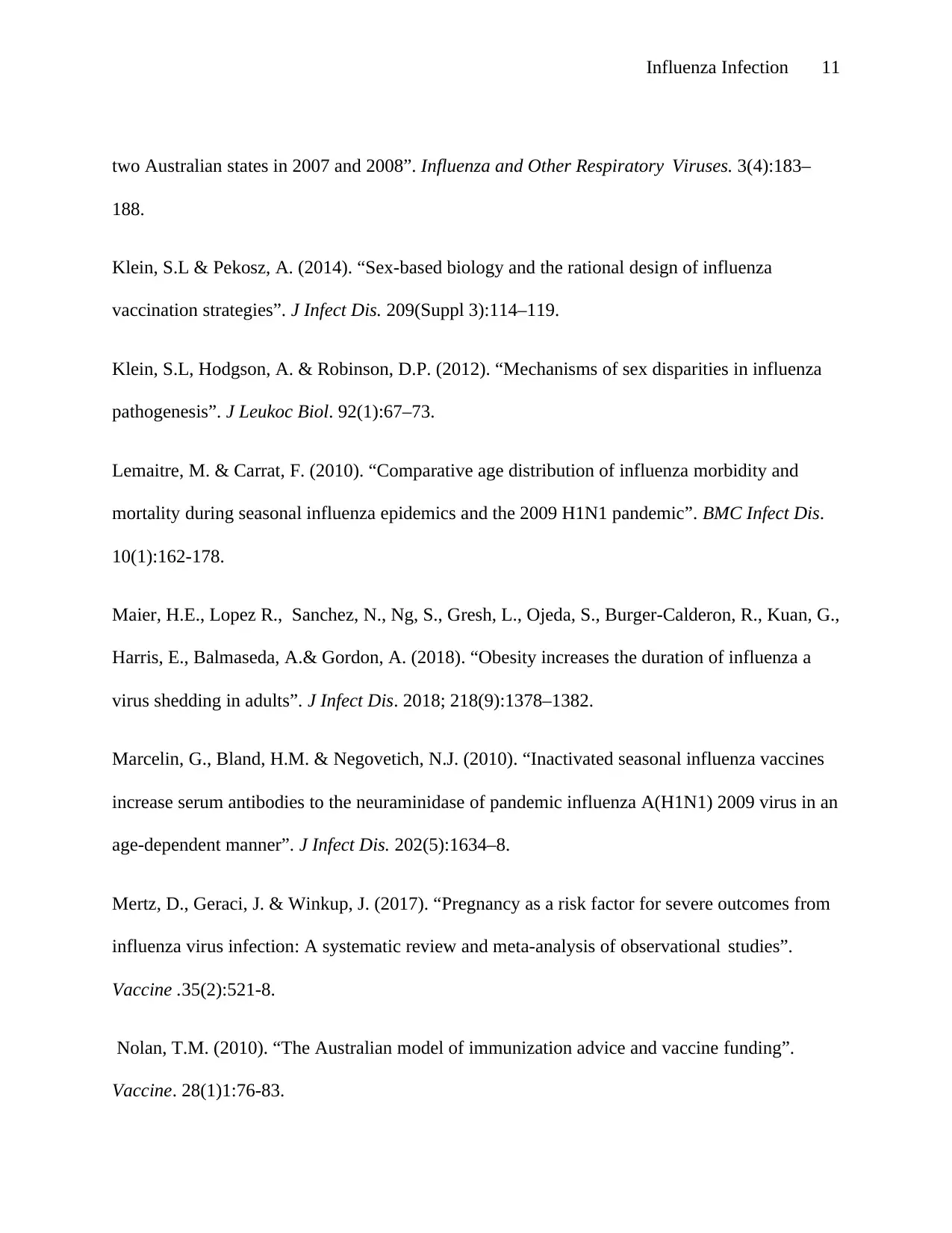
Influenza Infection 11
two Australian states in 2007 and 2008”. Influenza and Other Respiratory Viruses. 3(4):183–
188.
Klein, S.L & Pekosz, A. (2014). “Sex-based biology and the rational design of influenza
vaccination strategies”. J Infect Dis. 209(Suppl 3):114–119.
Klein, S.L, Hodgson, A. & Robinson, D.P. (2012). “Mechanisms of sex disparities in influenza
pathogenesis”. J Leukoc Biol. 92(1):67–73.
Lemaitre, M. & Carrat, F. (2010). “Comparative age distribution of influenza morbidity and
mortality during seasonal influenza epidemics and the 2009 H1N1 pandemic”. BMC Infect Dis.
10(1):162-178.
Maier, H.E., Lopez R., Sanchez, N., Ng, S., Gresh, L., Ojeda, S., Burger-Calderon, R., Kuan, G.,
Harris, E., Balmaseda, A.& Gordon, A. (2018). “Obesity increases the duration of influenza a
virus shedding in adults”. J Infect Dis. 2018; 218(9):1378–1382.
Marcelin, G., Bland, H.M. & Negovetich, N.J. (2010). “Inactivated seasonal influenza vaccines
increase serum antibodies to the neuraminidase of pandemic influenza A(H1N1) 2009 virus in an
age-dependent manner”. J Infect Dis. 202(5):1634–8.
Mertz, D., Geraci, J. & Winkup, J. (2017). “Pregnancy as a risk factor for severe outcomes from
influenza virus infection: A systematic review and meta-analysis of observational studies”.
Vaccine .35(2):521-8.
Nolan, T.M. (2010). “The Australian model of immunization advice and vaccine funding”.
Vaccine. 28(1)1:76-83.
two Australian states in 2007 and 2008”. Influenza and Other Respiratory Viruses. 3(4):183–
188.
Klein, S.L & Pekosz, A. (2014). “Sex-based biology and the rational design of influenza
vaccination strategies”. J Infect Dis. 209(Suppl 3):114–119.
Klein, S.L, Hodgson, A. & Robinson, D.P. (2012). “Mechanisms of sex disparities in influenza
pathogenesis”. J Leukoc Biol. 92(1):67–73.
Lemaitre, M. & Carrat, F. (2010). “Comparative age distribution of influenza morbidity and
mortality during seasonal influenza epidemics and the 2009 H1N1 pandemic”. BMC Infect Dis.
10(1):162-178.
Maier, H.E., Lopez R., Sanchez, N., Ng, S., Gresh, L., Ojeda, S., Burger-Calderon, R., Kuan, G.,
Harris, E., Balmaseda, A.& Gordon, A. (2018). “Obesity increases the duration of influenza a
virus shedding in adults”. J Infect Dis. 2018; 218(9):1378–1382.
Marcelin, G., Bland, H.M. & Negovetich, N.J. (2010). “Inactivated seasonal influenza vaccines
increase serum antibodies to the neuraminidase of pandemic influenza A(H1N1) 2009 virus in an
age-dependent manner”. J Infect Dis. 202(5):1634–8.
Mertz, D., Geraci, J. & Winkup, J. (2017). “Pregnancy as a risk factor for severe outcomes from
influenza virus infection: A systematic review and meta-analysis of observational studies”.
Vaccine .35(2):521-8.
Nolan, T.M. (2010). “The Australian model of immunization advice and vaccine funding”.
Vaccine. 28(1)1:76-83.
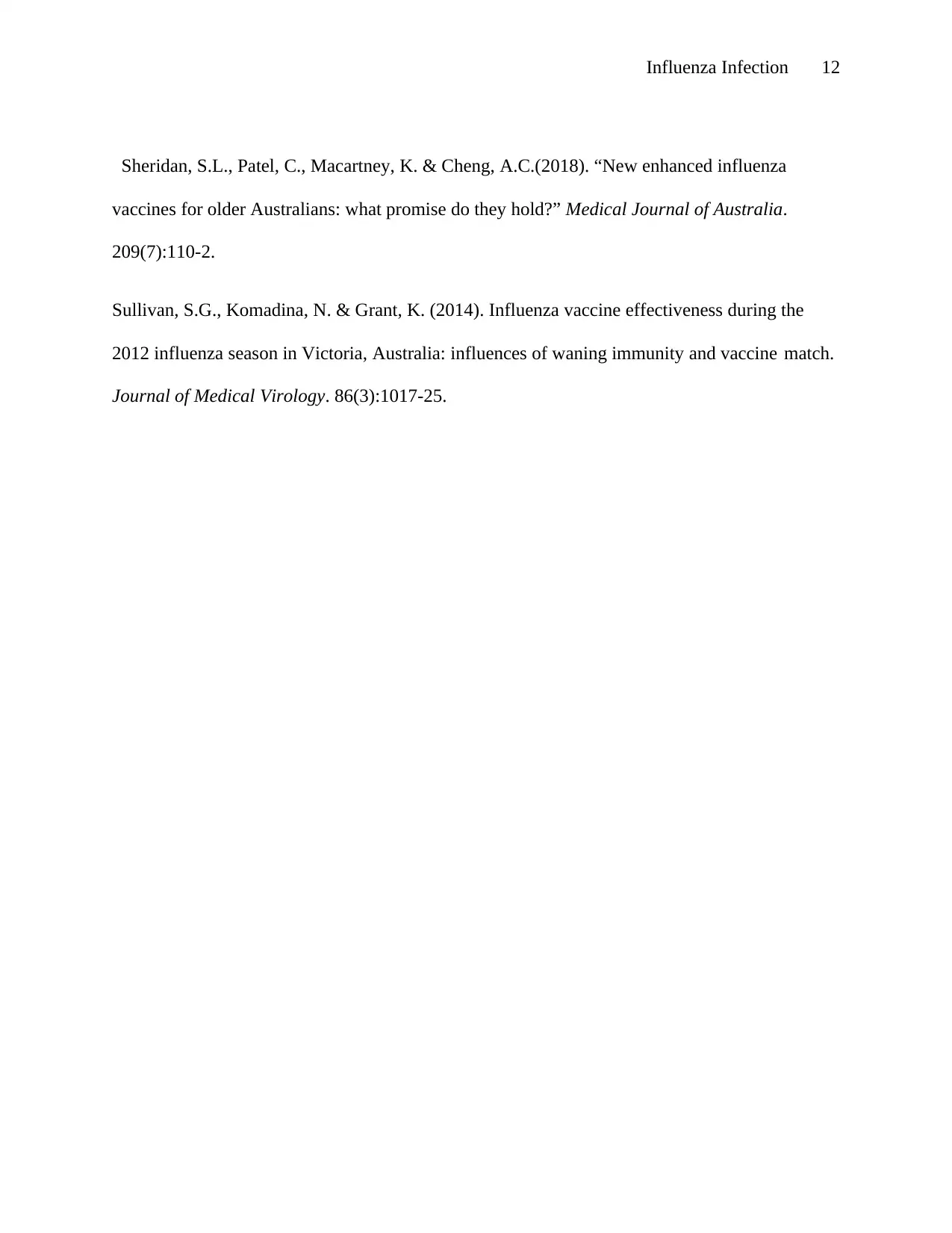
Influenza Infection 12
Sheridan, S.L., Patel, C., Macartney, K. & Cheng, A.C.(2018). “New enhanced influenza
vaccines for older Australians: what promise do they hold?” Medical Journal of Australia.
209(7):110-2.
Sullivan, S.G., Komadina, N. & Grant, K. (2014). Influenza vaccine effectiveness during the
2012 influenza season in Victoria, Australia: influences of waning immunity and vaccine match.
Journal of Medical Virology. 86(3):1017-25.
Sheridan, S.L., Patel, C., Macartney, K. & Cheng, A.C.(2018). “New enhanced influenza
vaccines for older Australians: what promise do they hold?” Medical Journal of Australia.
209(7):110-2.
Sullivan, S.G., Komadina, N. & Grant, K. (2014). Influenza vaccine effectiveness during the
2012 influenza season in Victoria, Australia: influences of waning immunity and vaccine match.
Journal of Medical Virology. 86(3):1017-25.
⊘ This is a preview!⊘
Do you want full access?
Subscribe today to unlock all pages.

Trusted by 1+ million students worldwide
1 out of 12
Related Documents
Your All-in-One AI-Powered Toolkit for Academic Success.
+13062052269
info@desklib.com
Available 24*7 on WhatsApp / Email
![[object Object]](/_next/static/media/star-bottom.7253800d.svg)
Unlock your academic potential
Copyright © 2020–2025 A2Z Services. All Rights Reserved. Developed and managed by ZUCOL.





